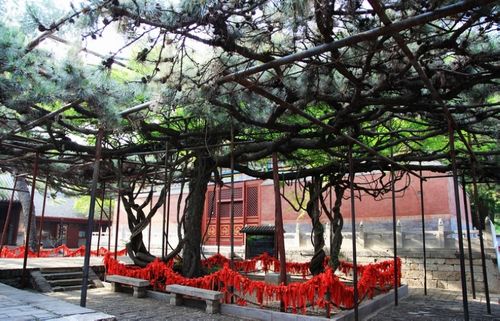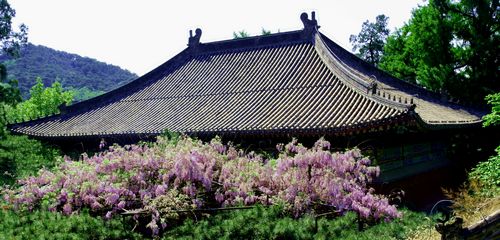8.Wisteria binding the Pine


In the west of the compound between Grand Bodhisattva Hall and Three Sages Hall is one of the three wonders of Hongluosi, Wisteria binding the Pine. It is actually a pine tree and two Chinese wisterias. The pine tree is 6 meters high with nine branches spreading in all directions. The two Chinese wisterias as thick as bowl mouth creep up the top of branches like a dragon winding around a jade pole, which increases the charm of the pine tree. The luxuriant pine tree and wisterias form a natural huge umbrella which shelters from heat or light for about 300 square meters. In early May every year, the branches are wigged down with the flowers of Chinese wisterias like clusters of purple agate, which is like a purple propitious cloud floating among hall buildings. The strong scent of flowers penetrates the whole temple. In ancient times, during flower season, the abbot of Hongluosi invited the abbots or elders of a Buddhist monastery of the temples nearby to enjoy flowers and talk about Buddhism under the tree. According to the record in the events inscribed on a tablet of Daming temple, Hongluo Mountain, when the breeze is blowing at night, you will hear the sound which is like the clang of gold and silver. As the common saying goes, if wisteria winds a pine tree, it is difficult for a pine tree to survive, while the two Chinese wisterias and a pine tree in Hongluosi grow harmoniously for over 800 hundred years. The wisteria can’t live without the pine tree, while the pine tree can’t live without the wisteria. Thus, it is called one of the three wonders of Hongluosi.

In front of the Three Sages Hall, there are two peonies of over 260 years old. The two peonies have the same florescence (in early May) as the wisteria. When they are in blossom, the scenery is really wonderful. In recent year’s record, a peony can have at most 49 blooms. The bloom with the purple double petals can reach 20 centimeters in diameter.



